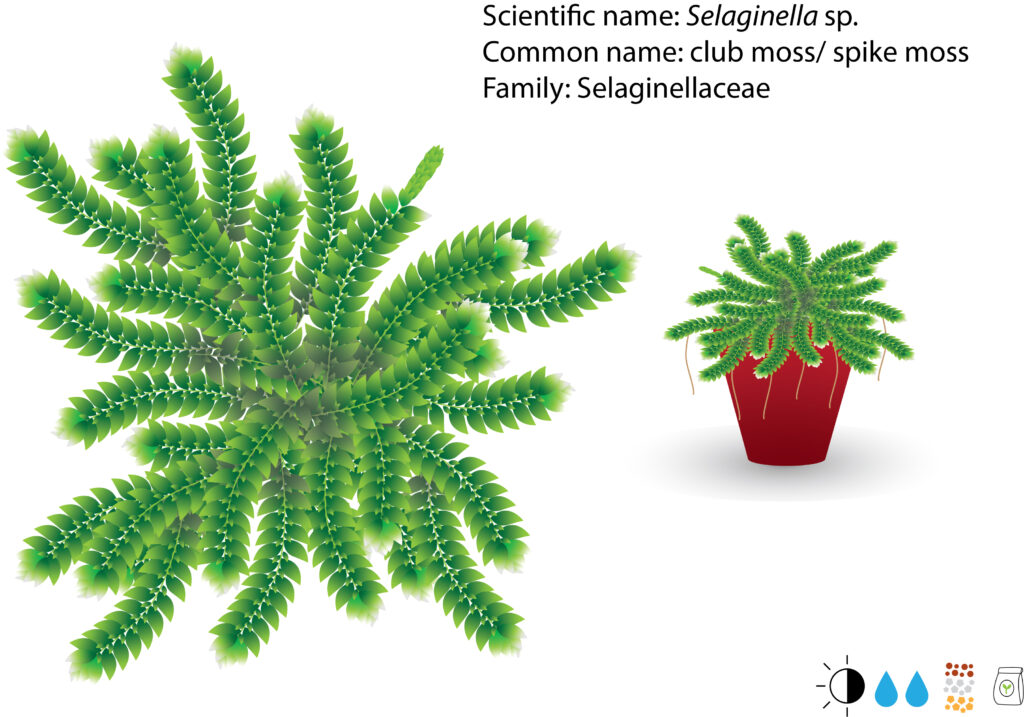Selaginella is an evergreen, rhizomatous perennial in the genus of Selaginella from the family of Selaginellaceae. Generally known as spike moss or arborvitae ferns, mainly found in tropical and warm-temperate zones, Selaginella is highly valued as small ornamental plants that provide a very satisfactory blossom miracle. Although share resemblance with the true rose of Jericho (Anastatica hierochuntica), which is a flowing plant in the family Brassicaceae. They are absolutely botanically unrelated because Selaginella is one of the earliest vascular plants on earth with a history of about 410 million years which is 280 million years earlier than that of flowing plants. Thus, Selaginella is also known as the False roses of Jericho. As pteridophytes, Selaginella does not produce flowers or seeds but rather lives through alternative life cycles, known as metagenesis with two generations, between sporophyte and gametophyte. Similar to that of ferns, horsetails, and lycophytes, who produce spores. But unlike lycophytes which are homosporous that produce only one type of unisexual or bisexual (hermaphroditic) spores, Selaginella is heterosporous that produces two types of spores with separate female and male spores. There are about seven hundred species of Selaginella that have been identified and some of them have gained popularity as indoor plants.
Selaginella lepidophylla probably is the most unique Selaginella species. It’s mostly renowned for its ability to survive in almost complete desiccation conditions, native in the dryland of Mexico and can be found from Texas to El Salvador, also referred to as doradilla which means ‘little gold-leafed one’ or ‘resurrection plant’. Other common names include resurrection plant, resurrection moss, dinosaur plant, Siempre Viva, and stone flower. During dry weather, the stems curl into a tight ball and tumble around searching for new accommodations, uncurl only when moisture is detected. It has a long history in Mexican as traditional medicine for gall and renal stones, diuresis, stomach, and liver inflammation. It was believed to have diuretic activity and can inhibit the activities of certain enzymes to improve inflammation. The dried and powdered form of the leaves can be rubbed and applied on painful body parts as physical protection against illness caused by bewitchment.
Among all popular Selaginella species, frosty-fern is the most favored ornamental plant, especially in festive seasons like Christmas for its mini cypress-like appearance and vivid emerald and dark green color. Selaginella kraussiana, commonly known as frosty-fern, spreading club moss, trailing spike moss, or Krauss’s spike moss is a species with trailing branched stems that originated from southern Africa and the Azores. This species forms a bright green feathery mesh up to one inch high. A dwarf form of this species is available as ‘Aurea’ and ‘Variegate’ with beautiful light green and yellow colorings. There are other interesting species that come from Central America, such as Selaginella martensii, which has overlapping bright green leaves on six inches with a high stem trail and roots from the nodes on this species.
Another unique Selaginella from China, Selaginella uncinata has mid-green leaves that age to plum color with a peacock blue sheen, which is commonly known as peacock moss, rainbow fern, or blue spike fern due to its dwarf morphology. This peacock moss is a trailing perennial with almost leafless stems with densely branched side shoots. It reaches only two inches in height but has an indefinite spread in the vertical dimension. This feature makes it a splendid hanging-basket plant in the house. Another famous species of this genus is Selaginella willdenovii with the common name Willdenow’s selaginella that can be found in Southern China, Indonesia, as well as the Himalayas that could reach up to twenty feet. It branches from the base and bears blue-green or bronze-green oval leaves.
Valued by their attractive branching foliage, Selaginella can be planted as potted indoor-plants or used for terrarium decoration. Some species are suitable for hanging baskets or in the cooler areas of a greenhouse. Some rare species might be available from high-end growers and nurseries. Generally, these frost-tender plants prefer partially-shade and moderately fertile, moist but well-drained soil. Watering can be done by placing the pot in a saucer of water, letting it absorb for fifteen minutes, and then removing the plant from the saucer. Avoid watering the foliage directly as the leaves are densely overlapping with each other. The water droplets that remained in between the leaves may result in leave rots followed by many diseases. A consistent humidity is a key for them to grow well in the terrarium and house.
Selaginella can be propagated from spores or by divisions. However, propagation from spores might be challenging because at the stage of gametophytes, they are not capable of photosynthesis so need to live with symbionts such as algae or fungi for energy supply. It’s recommended to propagate through vegetative reproduction by the division of crowns or rhizome which grows as a colony at the stage of the sporophyte. The sporophyte stage develops from the zygote produced through fertilization of a haploid egg cell and a haploid sperm cell forming a diploid multicellular stage. The plants have fully developed crowns and roots that can be separated for new plants.

Further reading:
Rätsch. C. & Műller-Ebeling. C. (2009). Pagan Christmas – The plant, spirits, and rituals at the origins of Yuletide. Rochester, Vermont.